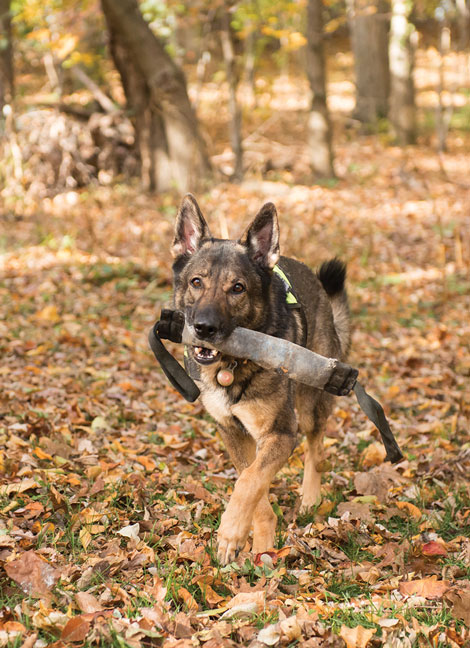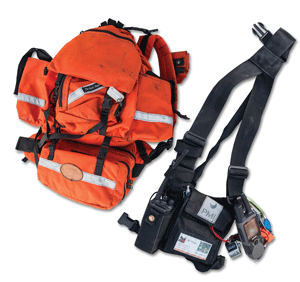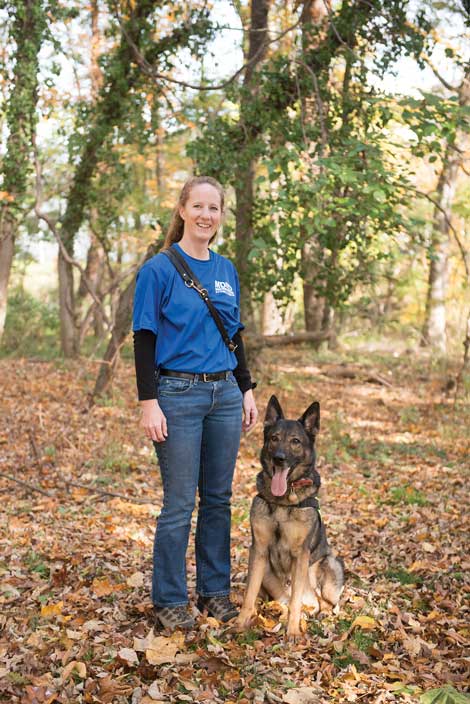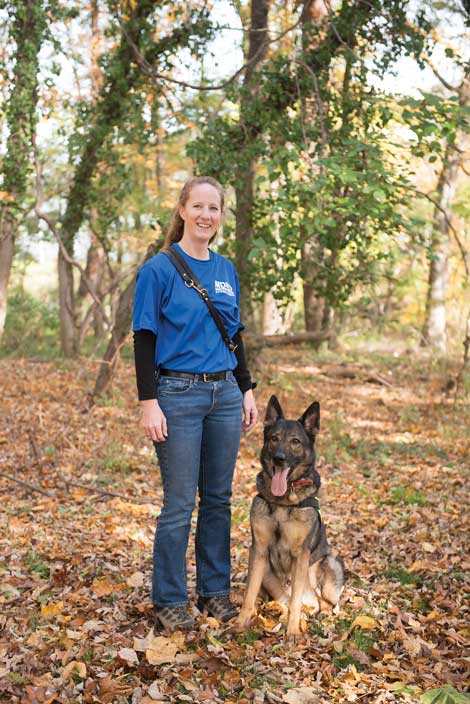Train a Dog to Perform Search and Rescue
 Lisa Kakavas ’94, psychology, spends her days working as textbook manager in the UMBC Bookstore. At night and on weekends, however, you’ll find her out in the field with her sable German shepherd, Zildjian (or “Z” for short), working with Mason-Dixon Rescue Dogs. Kakavas is president of the all-volunteer group, which trains dogs – and their owners – to seek and find missing people, both alive and dead.
Lisa Kakavas ’94, psychology, spends her days working as textbook manager in the UMBC Bookstore. At night and on weekends, however, you’ll find her out in the field with her sable German shepherd, Zildjian (or “Z” for short), working with Mason-Dixon Rescue Dogs. Kakavas is president of the all-volunteer group, which trains dogs – and their owners – to seek and find missing people, both alive and dead.
How do you transform a dog from lovable companion to hard-working rescue/recovery K9?
Step 1: FIND A TEAM TO TRAIN WITH
“There are numerous search and rescue groups around Maryland, and they are generally very open to helping newbies get started,” says Kakavas. She advises starting with a web search to identify groups that are close to where you live. You’ll likely be invited to a field day – most groups hold regular weekly sessions – and meet everyone involved in the group to see if you’re a good fit for that team. Training a rescue dog is a rigorous, long-term project, and it’s important that both the group’s location and overall zeitgeist work for you. “You’ll be spending a lot of pretty intense time with these folks,” Kakavas observes.
Step 2: LEARN FIELD SKILLS
Interestingly, the first step in training a search and rescue dog does not involve an actual canine. “You need to solidify certain skills yourself, as a handler, before you can start teaching your dog,” says Kakavas. On the learning curve: navigation with map, compass and GPS. You’ll also study search strategy – i.e., how to evaluate an area of land to devise the most effective and efficient search approach, since “when you’re looking for a live individual, time is of the essence” – and “scent theory,” or understanding how terrain, weather patterns and even vegetation affect how a search target’s scent disperses in the landscape.
This initial human training period varies, depending upon the individual’s previous outdoors experience and how much time they can devote to what is ultimately a volunteer gig. “The ballpark is about one year,” Kakavas says.
Step 3: CHOOSE YOUR DOG
 Ideally, those interested in learning to do search and rescue acquire the dog after they’ve established their own skills. “This way you get to see a multitude of working dogs and start to understand what breed you’d like to work with, what makes a good search dog,” she says. Although many rescue canines come from certain working breeds like German shepherds, border collies, and Labrador retrievers, Kakavas says that any pup – so long as it is less than two years old – has potential. A dog’s particular characteristics are more important than its breed. “Look for a dog that is independent yet sociable, tractable, eager to learn, agile, and fearless,” she says. “And has a good nose!”
Ideally, those interested in learning to do search and rescue acquire the dog after they’ve established their own skills. “This way you get to see a multitude of working dogs and start to understand what breed you’d like to work with, what makes a good search dog,” she says. Although many rescue canines come from certain working breeds like German shepherds, border collies, and Labrador retrievers, Kakavas says that any pup – so long as it is less than two years old – has potential. A dog’s particular characteristics are more important than its breed. “Look for a dog that is independent yet sociable, tractable, eager to learn, agile, and fearless,” she says. “And has a good nose!”
Step 4: EARN “THE PAYCHECK”
While a handler’s motivation is abstract – help the community, save lives, bring a loved one home to their family – dogs are motivated by food and play. Search and rescue training is built around the “paycheck” of a treat or some tug of war as a reward for performing tasks. Training a dog to certification level typically requires one to two years, when working at it part time, and involves activities like “runaways” which use the handler and a volunteer “subject” for the dog to find. “The subject runs away maybe 30 feet, which kicks in the dog’s natural prey drive even as they can still see the person,” Kakavas explains. Every time the dog goes to a subject, it is rewarded with a very vigorous playtime. The distance gets longer and longer, until eventually the subject is out of the dog’s sight. The dog by this time understands the need to find a person in order to get their reward, thus naturally transitioning from sight to scent in order to go collect that paycheck.
“Training is essentially coupling the dog’s natural drives with a reward, over and over again until it’s deeply automatic,” says Kakavas. “Our dogs are searching for any human scent. No matter who is out there in the field, the dogs will find them, which we want: even if it’s not the missing person, it is someone who is a potential witness.”
Step 5: DON’T FORGET TO HAVE FUN
 Doing searches, which can be long and grueling, must also be fun for both dog and handler. Especially the dogs: if it’s not fun, they simply won’t do it. Fortunately, says Kakavas, search and rescue is the canine equivalent of a big game of hide and seek. And the handler? “Just watching that dog do a job it is born to do, just the way you’ve trained them to do it – that is the human paycheck.”
Doing searches, which can be long and grueling, must also be fun for both dog and handler. Especially the dogs: if it’s not fun, they simply won’t do it. Fortunately, says Kakavas, search and rescue is the canine equivalent of a big game of hide and seek. And the handler? “Just watching that dog do a job it is born to do, just the way you’ve trained them to do it – that is the human paycheck.”
TOOLS OF THE TRADE
- Dog treat or toy, depending upon your dog’s preference
- A GPS, compass, and map
- Working knowledge of search strategy
- Spirit of fun and adventure
By The Numbers
 Amount of area searched: Anywhere from a few hundred square feet to 80 acres.
Amount of area searched: Anywhere from a few hundred square feet to 80 acres.
Number of years Kakavas has been training dogs and doing rescue and recovery: 14.
Furthest Kakavas has ever traveled to do a search: 3,500 miles, searching for a lost hiker in Peru.
Number of searches Kakavas and Z have done in their five years of working together: more than 50.
– Michelle Gienow
Tags: Fall 2014




